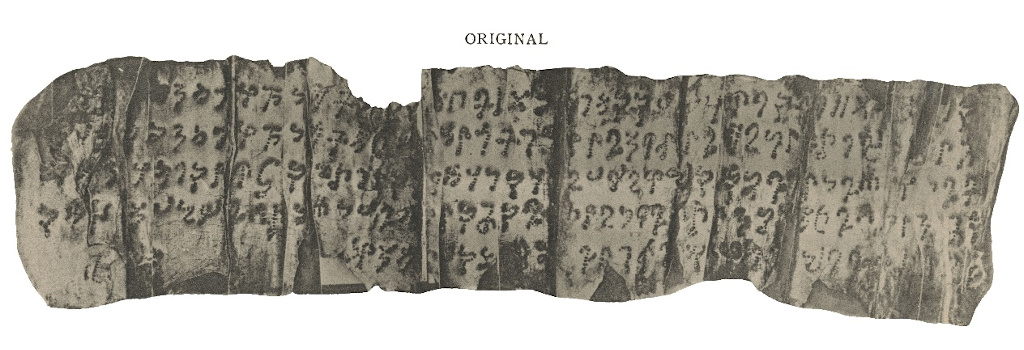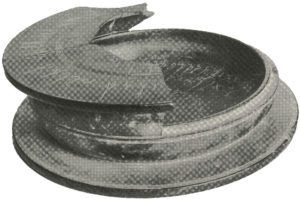Gāndhārī Relic Inscriptions
The international effort underway to edit Gāndhārī manuscripts has added significantly to our understanding of the development and transmission of Buddhist literature rather than to our understanding of the ritual and religious practices of Gandhāran Buddhism. The focus of this collection is the characterization of the ritual of relic establishment through the detailed analysis of formulaic patterns in the content of reliquary inscriptions.

Significance
The reports of the earlier Chinese travellers record a Gandhāra resplendent with stupas and monasteries and a Buddhism which might reasonably be characterized as a relic cult. The archaeological record of representative sites supports such a characterization: evidence for the practice of relic establishment is consistent and ubiquitous. Indeed, relic establishment might be understood as perhaps the most significant element of Buddhist religious culture in the Gandhāran region at least in the period covered by the inscription record. Relic inscriptions are central to our understanding of the ritual practice of relic establishment.
They are highly formulaic and, located at the nexus of state and monastic hegemony, might be characterized as truly foundational artefacts. Relic inscriptions might be seen to be comparable, if not exceeding, Aśokan inscriptions in terms of their civilization defining normative significance.
Relics and ritual practices are an important area in contemporary Buddhist studies as a corrective to 20th century predominance of doctrinal studies in the field. In order to understand religious practice in early Indian Buddhism, it is necessary to focus on religious constructions, inscriptions and art historical remains rather than exclusively privileging canonical texts: an approach to Buddhist studies as an ‘archaeology of religion’ as distinct from a text based ‘history of religion’ (Schopen 1987). Relics in general are of great interest in the field. Recent monographs have been devoted to the primacy of relics and related practices in Buddhism (Strong 2004) and to Gandhāran reliquaries in particular (Jongeward 2012).
Collection
Whilst only a small fraction (approx. 5%) of the entire corpus of Gāndhārī inscriptions, the 67 relic inscriptions written in the Kharoṣṭhī script constitute the vast majority of inscribed reliquaries known from Indian Buddhism: Sanskrit or Prakrit relic inscriptions written in Brahmi are rare. The earliest date from the mid second century BCE and the latest from mid to late second century CE in line with the decline of the Kuṣāṇa empire and their lavish patronage of Buddhist institutions. Their geographic distribution also corresponds to the extent of the territories of the Kuṣāṇas and their predecessors. Particularly concentrated around Taxila and sites associated with the Oḍi kings of Swat and the Apraca kings if Bajaur in North West Pakistan, relic inscriptions were also found as far west as Wardak in Afghanistan (Salomon 2012).
Catalogues and Editions
This collection of 67 inscriptions builds upon previous catalogues of Gāndhārī inscriptions and introduces a new approach to classification and naming of relic inscriptions. Four inscriptions, previously overlooked, have been included based upon their formulaic structure and the relationship between the establishment of a stupa or monastery and the establishment of relics.
- Konow, S. (1929). Kharoshṭhī Inscriptions with the exception of those of Aśoka. Corpus Inscriptionum Indicarum 2.1. Calcutta, Government of India.
- Neelis, J. (1992). A survey of Recently discovered Kharosthi Inscriptions MA Thesis, University of Texas at Austin.
- Baums, S. (2012). Catalog and Revised Text and Translations of Gandhāran Reliquary Inscriptions. Gandhāran Buddhist Reliquaries. D. Jongeward. Seattle, University of Washington Press.

Most relic inscriptions have more than one edition (many with four or more) with wide variation around naming. Historically, the identification is with the reliquary, stupa, sheet or stone inscribed rather than the text itself. Whilst the names adopted by various editors are retained for their editions, a structured naming protocol has been adopted which uniquely identifies both the inscription and the inscribed object. Where previous editors might have referred to the Kopśkasa reliquary this approach allows for the distinct inscriptions on that reliquary to be uniquely identified: Bapasariḍhaparida and Sabhakaa and Saareṇa – stone cylinder lid (Azes 83) and Kopśakasa – stone cylinder base.
Formulae Analysis
Gandhāran relic inscriptions are highly formulaic. In general, they record the establishment of relics by a notable in a stūpa, the acknowledgement of the lineage and associations of that notable, the designation of who is to be honoured by the establishment, what benefit might accrue and who might be the beneficiaries of that benefit, the articulation of the qualities and attainments of the Buddha and the attributes of the relics.
The objective of the research project which initiated the current collection was to characterize the ritual practice of relic establishment through the detailed analysis of formulaic patterns in the content of Gandhāran relic inscriptions. In particular, to expose insights into Buddha bodies and the benefits of relic establishment through the application of digital models, methods and platforms to the implementation of formulaic sequences and the analysis of genre.
The application of an internally coherent formulae ontology (a synthesis of the semantic and the syntactic) provides the substrate for an algorithmic generation of formulae type and a rich characterization of genre across this small-scale collection. The visualization of formula sequences, both within the context of an inscription, and compared across the corpus, provides an analysis tool to identify inflection points and pattern anomalies against normative types: data visualization as an iterative pattern analysis and ontology design practice.
The efficacy of the methodology (an augment to, rather than a replacement of, conventional philological methods) in generating alternative solutions and resolutions to intractable transcription and translation issues is the predicate for the development of the new editions in this collection.
It is anticipated that analysis of the relationships and inflection points between the complexes of formulae can generate insights into significant aspects of the characterization of the ritual of relic establishment grounded in the historically bounded cultural and religious milieu encapsulated by the collection.

Digital Editions
The digital editions included in this collection are ‘cubed’ texts. This approach builds subsequent editions through a process of cloning and editing from an initial reference edition substrate and exposes scholarly innovation at its most granular. This homage to historical scholarship, where scholarly contribution is encapsulated in the provenance of each akṣara, syllable, token and compound provides a platform for research innovation. Contemporary collaborators can clone and develop a new edition with their own interpretations which may comprise new readings and/or a mash-up of previous editions. The renditions included in this collection for each edition include:
- Transliteration: Image and transliteration.
- Glossary: Image, transliteration, and glossary.
- Translation: Translation, and chāyā.
- Script: Image, transliteration, and script chart
- Structure: Visualize the text and formulae structure.
- TEI: Transliteration in EpiDoc TEI format.
- HTML: Transliteration in HTML format.
Bibliography
Jongeward, D. (2012). “Appendix – Tables of Gandhāran Reliquaries.” in David Jongeward, Elizabeth Errington, Richard Salomon and Stefan Baums, Gandharan Buddhist Reliquaries. Gandharan Studies, Volume 1. Seattle.
Salomon, R. (2012). “Gandharan Reliquary Inscriptions.” in David Jongeward, Elizabeth Errington, Richard Salomon and Stefan Baums, Gandharan Buddhist Reliquaries. Gandharan Studies, Volume 1, pp. 164–99. Seattle.
Schopen, G (1987) “Burial ‘ad sanctos’ and the Physical Presence of the Buddha in Early Indian Buddhism: A Study in the Archeology of Religions.” Religion 17: 193–225
Strong, J. (2004). Relics of the Buddha. Princeton, Princeton University Press.

